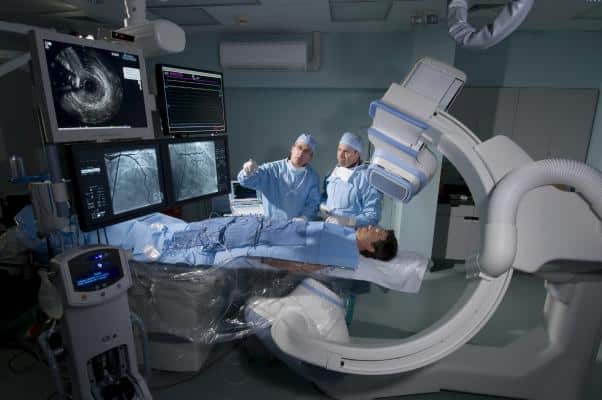Fluoroscopy: What it is, what it’s used for, & its benefits
In simple terms, fluoroscopy is a medical imaging technique that uses X-rays to generate real-time images of the internal structures of the body.
In this article, we’ll explore exactly what fluoroscopy is, what it’s used for, and the numerous benefits it brings to hospitals and patients.

What is Fluoroscopy?
Fluoroscopy is a specialised imaging technique that employs a continuous X-ray beam to capture moving images of the body in real time.
Unlike traditional X-rays that produce static images, fluoroscopy enables healthcare professionals to observe internal organs, systems, and medical procedures as they unfold.
The name “fluoroscopy” originates from the fluorescent screen used to visualise X-ray images.
How does Fluoroscopy work?
Let’s take a closer look at how fluoroscopy works. During a fluoroscopy procedure, the patient is positioned between an X-ray source and a fluorescent screen or digital detector.
The X-ray machine emits a steady beam of radiation that passes through the body, creating real-time images. These images are then displayed on a monitor, allowing staff to assess anatomy, functionality, and the progression of medical interventions.
In recent years, digital fluoroscopy systems have gained popularity. These systems capture X-ray images digitally, offering improved image quality and convenient storage and retrieval of data. Digital fluoroscopy also enables image enhancement techniques, such as contrast adjustments and real-time image processing, further enhancing the diagnostic capabilities of this imaging modality.
What is Fluoroscopy used for?
Fluoroscopy finds applications across a wide range of medical disciplines. Let’s explore some of its notable uses:
- Interventional procedures: Fluoroscopy plays a crucial role in guiding minimally invasive procedures, such as angiography, stent placement, and biopsies. It allows physicians to visualise the precise placement of medical devices and instruments in real-time, ensuring accuracy and reducing the risk of complications.
- Orthopedics: In orthopaedic practice, fluoroscopy aids in the diagnosis and treatment of fractures, joint dislocations, and spinal conditions. Surgeons can use fluoroscopy to accurately position implants, such as screws and plates, during surgical procedures.
- Gastrointestinal studies: Fluoroscopy is extensively used for gastrointestinal examinations, including barium studies. It helps evaluate the functioning of the oesophagus, stomach, intestines, and colon, assisting in the diagnosis of conditions like swallowing disorders, ulcers, and gastrointestinal blockages.
- Cardiology: Within cardiology, fluoroscopy assists in diagnosing and treating various cardiovascular conditions. It is used during cardiac catheterisation procedures to visualise the coronary arteries, heart chambers, and valves. This allows for the identification of blockages and congenital abnormalities and guides interventions like angioplasty and pacemaker placement.
What are the benefits of Fluoroscopy?
Fluoroscopy offers several advantages over other imaging modalities, including:
- Real-time visualisation: The ability to observe moving structures in real-time is invaluable in interventional procedures and dynamic evaluations.
- Guidance and precision: Fluoroscopy provides live guidance during minimally invasive procedures, enhancing accuracy and reducing complications.
- Flexible and versatile: Fluoroscopy can be applied to various medical specialities, making it a valuable tool for diagnosing and treating various conditions.
While fluoroscopy is highly beneficial, it’s important to consider the potential risks associated with X-ray radiation exposure. Staff in imaging departments have to take necessary precautions to minimise radiation dose and ensure patient safety during fluoroscopy procedures.
Related articles
How much do Imaging and Fluoroscopy stretchers cost to buy?
The 5 best Fluoroscopy and Imaging stretchers in 2023 – a complete comparison
How to avoid injury when moving and using a C-arm camera for fluoroscopy
Get in touch
Got a question or want to send us a message? Let’s talk.